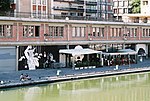Place de la Bataille-de-Stalingrad
Buildings and structures in the 10th arrondissement of ParisBuildings and structures in the 19th arrondissement of ParisSquares in Paris

The Place de la Bataille-de-Stalingrad is a square in the 19th arrondissement of Paris. It was named after the Battle of Stalingrad, one of the major battles of World War II. The square lies at the intersection of the Canal de l'Ourcq and the Canal Saint-Martin.
Excerpt from the Wikipedia article Place de la Bataille-de-Stalingrad (License: CC BY-SA 3.0, Authors, Images).Place de la Bataille-de-Stalingrad
Place de la Bataille de Stalingrad, Paris Quartier de la Villette (Paris)
Geographical coordinates (GPS) Address Phone number Website Nearby Places Show on map
Geographical coordinates (GPS)
| Latitude | Longitude |
|---|---|
| N 48.88361111 ° | E 2.37 ° |
Address
Chez Magda
Place de la Bataille de Stalingrad 6-8
75019 Paris, Quartier de la Villette (Paris)
Ile-de-France, France
Open on Google Maps








